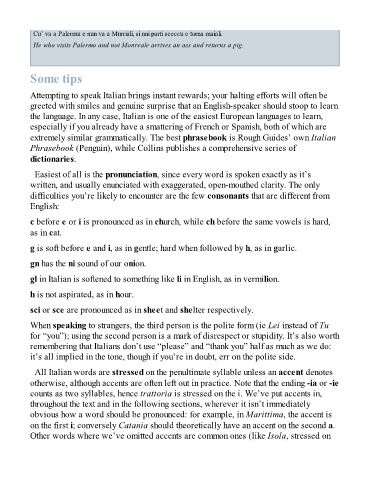Page 598 - The Rough Guide of Sicily
P. 598
Cu’ va a Palermu e nun va a Murriali, si nni parti sceccu e torna maiali.
He who visits Palermo and not Monreale arrives an ass and returns a pig.
Some tips
Attempting to speak Italian brings instant rewards; your halting efforts will often be
greeted with smiles and genuine surprise that an English-speaker should stoop to learn
the language. In any case, Italian is one of the easiest European languages to learn,
especially if you already have a smattering of French or Spanish, both of which are
extremely similar grammatically. The best phrasebook is Rough Guides’ own Italian
Phrasebook (Penguin), while Collins publishes a comprehensive series of
dictionaries.
Easiest of all is the pronunciation, since every word is spoken exactly as it’s
written, and usually enunciated with exaggerated, open-mouthed clarity. The only
difficulties you’re likely to encounter are the few consonants that are different from
English:
c before e or i is pronounced as in church, while ch before the same vowels is hard,
as in cat.
g is soft before e and i, as in gentle; hard when followed by h, as in garlic.
gn has the ni sound of our onion.
gl in Italian is softened to something like li in English, as in vermilion.
h is not aspirated, as in hour.
sci or sce are pronounced as in sheet and shelter respectively.
When speaking to strangers, the third person is the polite form (ie Lei instead of Tu
for “you”); using the second person is a mark of disrespect or stupidity. It’s also worth
remembering that Italians don’t use “please” and “thank you” half as much as we do:
it’s all implied in the tone, though if you’re in doubt, err on the polite side.
All Italian words are stressed on the penultimate syllable unless an accent denotes
otherwise, although accents are often left out in practice. Note that the ending -ia or -ie
counts as two syllables, hence trattoria is stressed on the i. We’ve put accents in,
throughout the text and in the following sections, wherever it isn’t immediately
obvious how a word should be pronounced: for example, in Marittima, the accent is
on the first i; conversely Catania should theoretically have an accent on the second a.
Other words where we’ve omitted accents are common ones (like Isola, stressed on

